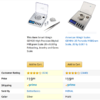While Gemini-20 has .02 gr resolution and can verify Ohaus ASTM Class 6 check weights down to .03 gr, it is usually stored away from the bench as Ohaus 10-10 and FA DS-750 with .1 gr resolution (recently replaced with WAOAW digital scale sensitive down to .04 gr) kept on the bench are more than adequate for everyday reloading tasks. Gemini-20 is used when I need to verify less than .1 gr.
Keep in mind for decades, countless matches including long-range/1000 yard Palma matches have been won with .1 gr resolution Ohaus 10-10 beam scales. If shooters were able to produce match winning loads with .1 gr resolution scales back then, we can certainly produce accurate and consistent loads today using .1 gr resolution scales whether beam or digital.
Absolutely agree with bolded part of your statement.
WAOAW digital scale sensitive down to .04 gr will display readings faster than my two Ohaus 10-10 beam scales and I would consider it a "step up" from .1 gr resolution scales -
https://www.thehighroad.org/index.p...ales-for-a-minute.836677/page-3#post-10849863
BTW, there's a newer model Gem 20 from My Weigh (maker of popular Gem Pro 250) with larger platform to use with powder pans. And yes, it's under $20 -
https://www.amazon.com/Smart-Weigh-...rd_wg=Zif1p&psc=1&refRID=MY8NDBNBEGZ1ARRDD5ZC
As already busted in the myth busting thread, cheaper $20 digital scales CAN be good enough for reloading. With advancement in technology, digital vs beam scales may follow the path of analog vs digital watches (how many of us still wear wind up watches?). Just be sure to operate digital scales within specified temperature range (59F to 95F), replace battery when readings become less consistent and verify with check weights (which should be done even with beam scales).
I have considered buying higher dollar digital scales/analytical balances but had to ask myself why when I can meter powders like Sport Pistol with less than .05 gr variance -
https://www.thehighroad.org/index.php?threads/lee-proauto-disk-mods.828480/#post-10682624
Sport Pistol (10 drops from .49 disk hole of Pro Auto Disk weighed on Gemini-20):
- 4.88 gr
- 4.88 gr
- 4.84 gr
- 4.84 gr
- 4.84 gr
- 4.84 gr
- 4.88 gr
- 4.86 gr
- 4.86 gr
- 4.84 gr
.04 gr variance - I think this is more than good enough for reloading.








